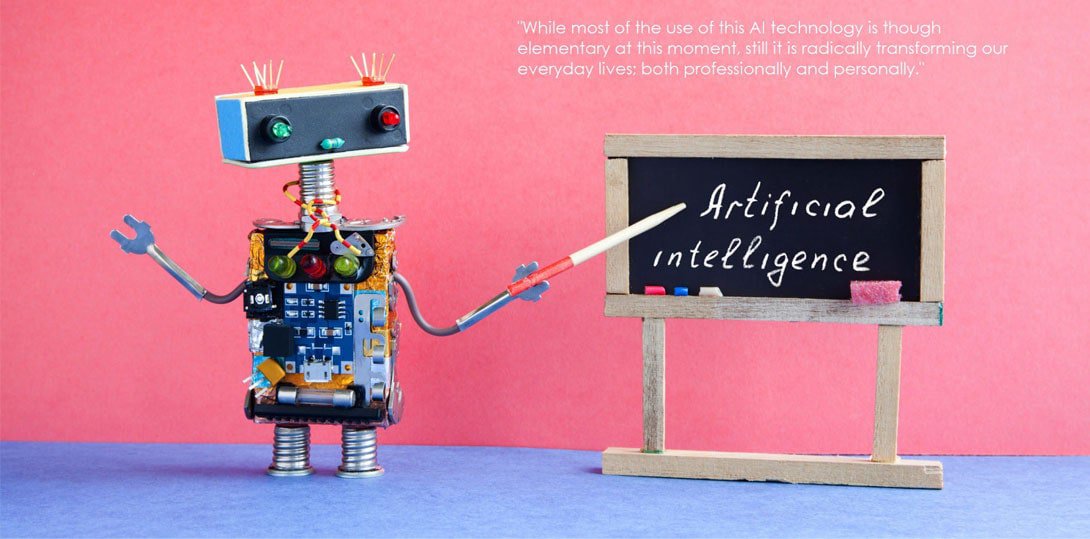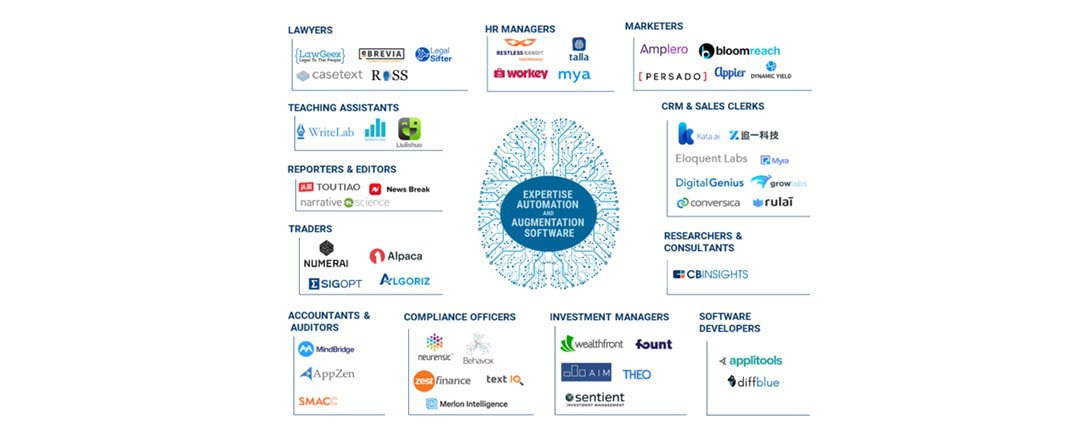AI and Automation in HR: Impact, Adoption and Future Workforce – Part 1
03.10.2019 | Soumyasanto Sen

Artificial intelligence (AI) has been changing our lives for decades, but today its presence is bigger than ever before. Sometimes, we don’t even realize it when a new AI-powered system, tool, or product appears and outperforms us, humans. In fact, AI is affecting human life on all kinds of levels varying from:
- The automation of tedious, time-consuming tasks to;
- The augmentation of human capabilities and;
- The amplification of human functions.
"While most of the use of this AI technology is stifoll elementary at the moment, it is radically transforming our everyday lives; both professionally and personally."
The benefits of AI and automation for HR and the workforce don’t come instantly, however. It’s a journey and one can see the short-term benefits of this journey in automation, the medium-term benefits in augmentation and finally the long-term benefits in the amplification of human activities or tasks.
Let’s take a look at the various effects of AI and automation on HR and the workforce in more detail. First, let’s find out what history was saying and how this shift towards AI and automation has been going on for a long time. After that, we’ll explore how we can adopt this new technology and what the basic strategies are to move forward as an organization while turning potential threats into opportunities.
AI and Automation in HR: Impact and Current State
AI is everywhere today, and there are many aspects to consider as to how it will impact the future of work.
“It’s now popping into almost every piece of software,” said Josh Bersin, principal and founder of Bersin by Deloitte. Based on research by Bersin by Deloitte, nearly 40% of companies are using some form of AI in HR alone.
According to Personnel Today, 38% of enterprises are already using AI in their workplace with 62% expecting to start using it as early as this year. According to Bersin by Deloitte, 33% of employees expect that their jobs will become augmented by AI in the near future.
Artificial intelligence is present in virtually every major industry from healthcare to advertising, transportation, finance, legal, education, and now also inside our workplaces.
We are already increasingly using chatbots and virtual assistants in our personal lives and now we can expect to use them in the workplace as well. For example to assist us in finding new jobs, answer FAQs, or receive coaching and mentoring. The use of artificial intelligence in organizations could help us to create a more seamless, more flexible, and more user-driven employee experience.
Let us take a look at a typical working day out of the daily life of the workforce so that we can clearly see some of the very common, practical uses, of AI.
Morning at home
- Many smart home devices include the ability to learn your behavior patterns and help you save money. Like the Nest thermostat that helps to increase your daily convenience and save energy.
- Amazon Alexa, Siri, Google Now, and Cortana are all intelligent digital personal assistants on various platforms. ‘How is the traffic today?’, ‘What’s on my schedule?’, ‘Remind me to call Mr. X at Ten o’clock’ and these assistants are responding quite well.
On the way to the office
- We probably all have seen someone reading the newspaper while driving to work (though quite risky currently!). But self-driving cars are getting more efficient. Google’s ‘Waymo’ and Tesla’s ‘Autopilot’ features are two good examples of this.
- Don’t have time to find some new music of your choice while hurrying into your office? Spotify uses deep learning to create the ultimate personalized playlist and suggest new music based on the user’s prior listening behavior.
Afternoon at the office
- The Hemingway app uses a primitive artificial intelligence that recognizes writing problems through natural language processing and polishes your writing structure. It helps in saving time and increases readability.
- We don’t need to struggle any longer with those meetings that have language barriers. Skype’s Translator currently works in 8 languages, and the text translator is available in more than 500 languages for instant messaging.
- Taking notes on a conference call can be difficult sometimes. Clarke ai is an AI bot that dials into your conference calls and does the entire note-taking work for you. Then, when the call is over, it emails the notes directly to your inbox.
- We usually have a bunch of emails piling up in our inboxes, even apart from spam. Google’s smart reply feature uses machine learning to analyze your emails and suggest quick, bite-sized responses you may want to send.
Time to leave the office
- Finding the right candidate for your team is not an easy task. Paradox uses Olivia as an AI assistant that allows you to focus on the entire candidate management. While VCV is an AI-powered Robot-Recruiter that searches for candidates; it calls them with questions using voice recognition, and then invites them to record a video interview. Glider is another example that can help in putting your hiring efforts on ‘auto-pilot’ when you’re out of the office.
- Need to recommend courses for your direct reports but can’t manage the time to do so? SAP SuccessFactors, Cornerstone, Talentsoft, and many others are already providing similar features to recommend courses based on a person’s career track and performance.
On the way home
- Forgot to schedule meetings for tomorrow? AI company X AI launched ‘Amy‘, a virtual personal assistant that automates the process of scheduling meetings.
Want to buy things before reaching your home but don’t remember what? Capitan is the smart shopping list that learns as you use it, to save you time and to avoid those missed items.
Evening at home
- Need to relax once you arrived home? Netflix recommends series and films based on the interests you’ve expressed and the judgments you’ve made in the past. No need to spend time searching.
- Want to buy things for the weekend or your holidays but too tired to do so? Amazon’s anticipatory shipping project hopes to send them you before you even need them. The North Face is using IBM Watson‘s platform to find a perfect jacket through a more engaging, personalized and relevant shopping experience.
These are only a few examples. Whether you are aware of it or not, AI has an immense impact on our daily (working) lives already. For most of us, AI technology is helping us do our jobs more efficiently and it’s generally making our lives – and jobs – easier.
As such, AI plays a big role today in transforming HR and the workforce; reducing human bias, increasing efficiency in candidate assessment, improving relationships with employees, improving compliance, increasing adoption of metrics, and improving workplace learning are some of the benefits organizations are experiencing today.
Jeanne Meister stated in her article, “The Future of Work: The Intersection of Artificial Intelligence and Human Resources“, how HR leaders will need to begin experimenting with all facets of AI to deliver value to their organizations. According to her, HR leaders are beginning to pilot AI to deliver greater value to the organization by using, for example, chatbots for recruiting, employee services, employee development, and coaching.
So far, recruiting and talent acquisition are the areas where AI solutions are most effective. There is a growing number of startups and service providers who target HR with artificial intelligence-based solutions for activities such as:
- sourcing (for example, Textio);
- interviewing (myInterview);
- on-boarding (Talla);
- coaching (Saberr) and;
- employee service centers (ServiceNow).
"“Currently, these AI-based solutions for HR & Workforce are more like analytical products driven by data and powered by next generation People Analytics.”"
When it comes to AI in HR, “The applications of AI basically are analytics applications, where the software is using history and algorithms and data to be smarter and smarter over time,” as per Bersin. The most interesting part of people analytics is the interface between AI and human proficiency.
Investments in AI are growing exponentially. Research firm IDC predicts that the market for AI will grow from $12.5 billion in 2017 to $46 billion by 2020, impacting all business practices across almost every industry.
The McKinsey Research Institute mentioned in its January 2017 report, “A future that works: Automation, employment, and productivity”, that automation technologies such as advanced robotics and artificial intelligence are powerful drivers of productivity and economic growth which can help create economic surpluses and increase overall societal prosperity.
According to McKinsey, automation could accelerate the productivity of the global economy by between 0.8 and 1.4 percent of the global GDP annually; assuming that the human labor replaced by automation rejoins the workforce.
On the other hand, their automation analysis found significant variations among various sectors of the economy and among the occupations within those sectors. Taking into account the technical, economic and social factors affecting the pace and extent of automation, McKinsey estimated that up to 30% of current work activities could be displaced by 2030.
"“McKinsey estimated that up to 30% of current work activities could be displaced by 2030”"
When the topic of artificial intelligence and its impact on jobs and the economy comes up, the principal focus of the conversation used to be on blue collar jobs. As per CB Insights and the State of Automation Report, there are 4.6M retail salespeople jobs at risk in the USA alone due to AI. The same thing goes for 4.3M cooks & waiters, 3.8M cleaners, 2.4M movers and warehouse workers, 1.8 M truck drivers and 1.2M construction workers.
According to CB Insights, a growing wave of AI-infused Expert Automation & Augmentation Software (EAAS) platforms will steer us towards a new era of AI-assisted and/or AI-enhanced productivity. These EAAS platforms use machine intelligence to replicate and augment human understanding.
This AI-enhanced productivity is starting to threaten white-collar jobs as well. And it’s going to impact most of the common professions like lawyers, HR, teachers, traders, sales, marketing, researchers, accountants, software developers, etc.

"“Are AI and Automation going to take our Jobs? This question was raised numerous times in the past and answer is, ‘NO’ as long as we can reskill ourselves for the future. We can however expect a structural shift in our jobs.”"
See also medium.com.


